
Staveley Mill Yard is a former bobbin (spool) mill, which is now used for a variety of different local industries, shops and other commercial ventures. It is situated in the centre of the village of Staveley, Cumbria, just off the main street.

Staveley Mill Yard is a former bobbin (spool) mill, which is now used for a variety of different local industries, shops and other commercial ventures. It is situated in the centre of the village of Staveley, Cumbria, just off the main street.
Staveley Mill was in existence before 1829 and was first known as Low Mill. The first documented owner was Thomas Taylor who was born in Kendal. Taylor (along with two of his daughters) died in 1832 following an outbreak of cholera in the area. The mill was then leased to Benjamin Turton from Yorkshire. In 1850 the mill was sold to Chadwick Bros. of Eagley Mills Bolton. In 1897 Chadwick's Mill was bought by J. P. Coats of Paisley and was later sold to a Mr. Dean in 1900 who renamed it The Staveley Wood Turning Co. Ltd. [1]
Edwin Brockbank, the son of a bobbin turner, became manager of the mill, partner in 1938 and subsequently owner in 1946. Staveley Mill Yard has remained in the Brockbank family for three generations, from Edwin to his son Roger and on to his son David, the present owner.
Kentmere Reservoir, situated north of Staveley beyond Kentmere village, was built by the mill owners to regulate the flow of the river for the benefit of mills and other industries downstream. A large water wheel powered the line shafting (some of which can be seen upstairs in Wilf’s Café) and under the balcony can be seen where the water was drawn off above the weir and channelled along the race, through an archway into the building to power the wheel. In 1902 the water-wheel was replaced by a turbine.
In the 20th century, The Staveley Wood Turning Co. Ltd. switched much of its production into tool handles and was able to prosper despite the introduction of plastic reels and bobbins in the 1950s. Much of the wood used by the wood mills was imported and by the 1990s most of the market was overseas and in 1993-94 the company placed machines overseas in Poland, Sri Lanka and Malaysia. Restructured as the Staveley Timber Company the business was mainly in Europe although some packing and finishing was still carried out in Staveley. Only ten people were then employed in Staveley, so the former coppice drying sheds and timber stores were adapted into light industrial units and shops. When the business finally closed the workers adapted and helped to redevelop the old exhausted mill buildings into more business units. There are now over 30 businesses on the site creating over 200 jobs. [2]
In 2011, a new building development was completed, adding a modern 20,000 Square Foot building to the complex. This building is now used as both offices and industrial units.
A footbridge across the river Kent was replaced in 2011 to improve access for the disabled. This was part of a Lake District National Park project called "Miles without Stiles". [3] The new footbridge was officially opened on 3 June by National Park Chief Executive Richard Leafe and writer and broadcaster Eric Robson.
Staveley Mill Yard is currently used for a mixture industry, retail, galleries, creative studios and artisan crafts. Its industries and shops function to service both the local population and further afield and also as an attraction to visitors on their way into the Lake District. It is especially known for Wilf's Cafe and Wheelbase, the UK's largest bike shop.[ citation needed ] Recent additions also include Hawkshead Brewery (a local real ale microbrewery), The Blind Chocolatier and Staveley Natural Health Centre. It is also known as the site of for art and design studios and also artisan crafts such as furniture and bread.
There is also an emphasis on using natural resources at Staveley Mill Yard. For this reason, the turbine which replaces the original water wheel is now being used to generate 10–15% of the site's energy requirements. [4]
Spinning is a twisting technique to form yarn from fibers. The fiber intended is drawn out, twisted, and wound onto a bobbin. A few popular fibers that are spun into yarn other than cotton, which is the most popular, are viscose, animal fibers such as wool, and synthetic polyester. Originally done by hand using a spindle whorl, starting in the 500s AD the spinning wheel became the predominant spinning tool across Asia and Europe. The spinning jenny and spinning mule, invented in the late 1700s, made mechanical spinning far more efficient than spinning by hand, and especially made cotton manufacturing one of the most important industries of the Industrial Revolution.

The River Don is a river in South Yorkshire and the East Riding of Yorkshire, England. It rises in the Pennines, west of Dunford Bridge, and flows for 69 miles (111 km) eastwards, through the Don Valley, via Penistone, Sheffield, Rotherham, Mexborough, Conisbrough, Doncaster and Stainforth. It originally joined the Trent, but was re-engineered by Cornelius Vermuyden as the Dutch River in the 1620s, and now joins the River Ouse at Goole. Don Valley is a UK parliamentary constituency near the Doncaster stretch of the river.
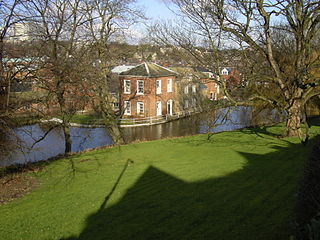
The Porter Brook is a river which flows through the City of Sheffield, England, descending over 1,000 feet (300 m) from its source on Burbage Moor to the west of the city to its mouth where it joins the River Sheaf in a culvert beneath Sheffield railway station. Like the other rivers in Sheffield, its steep gradient made it ideal for powering water mills and works associated with the metalworking and cutlery industries, and around 20 dams were constructed over the centuries to facilitate this. At its lower end, it is extensively culverted, but parts of it are gradually being restored to open channels, as part of a daylighting scheme for the city.

The River Rother, a waterway in the northern midlands of England, gives its name to the town of Rotherham and to the Rother Valley parliamentary constituency. It rises in Pilsley in Derbyshire and flows in a generally northwards direction through the centre of Chesterfield, where it feeds the Chesterfield Canal, and on through the Rother Valley Country Park and several districts of Sheffield before joining the River Don at Rotherham in Yorkshire. Historically, it powered mills, mainly corn or flour mills, but most had ceased to operate by the early 20th century, and few of the mill buildings survive.
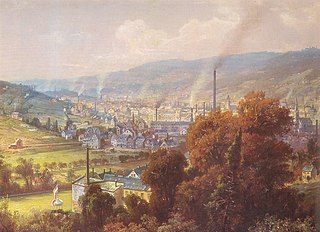
Textile manufacture during the British Industrial Revolution was centred in south Lancashire and the towns on both sides of the Pennines in the United Kingdom. The main drivers of the Industrial Revolution were textile manufacturing, iron founding, steam power, oil drilling, the discovery of electricity and its many industrial applications, the telegraph and many others. Railroads, steamboats, the telegraph and other innovations massively increased worker productivity and raised standards of living by greatly reducing time spent during travel, transportation and communications.

The River Kent is a short river in the county of Cumbria in England. It originates in hills surrounding Kentmere, and flows for around 20 miles (32 km) into the north of Morecambe Bay. The upper reaches and the western bank of the estuary are located within the boundaries of the Lake District National Park. The river flows in a generally north to south direction, passing through Kentmere, Staveley, Burneside, Kendal and Sedgwick. Near Sedgwick, the river passes through a rock gorge which produces a number of low waterfalls. This section is popular with kayakers as it offers high quality whitewater for several days after rain. The village of Arnside is situated on the east bank of the Kent estuary, just above Morecambe Bay, and a tidal bore known as the Arnside Bore forms in the estuary at this point on high spring tides.

Staveley is a village in the South Lakeland district, in Cumbria, England. Historically part of Westmorland, it is situated 4 miles (6 km) northwest of Kendal where the River Kent is joined by its tributary the Gowan. It is also known as Staveley-in-Westmorland and Staveley-in-Kendal to distinguish it from Staveley-in-Cartmel. There are three civil parishes – Nether Staveley, Over Staveley and Hugill (part). Their total population at the 2011 Census was 1,593 but this includes those living in the hamlet of Ings in Hugill parish.

Kentmere is a valley, village and civil parish in the Lake District National Park, a few miles from Kendal in the Westmorland and Furness district of Cumbria, England. Historically in Westmorland, at the 2011 census Kentmere had a population of 159.

Stott Park Bobbin Mill is a 19th-century bobbin mill and now a working museum located near Newby Bridge, Cumbria, England. Built in 1835 the mill was one of over 65 such buildings in the Lake District, which provided wooden bobbins to the weaving and spinning industry primarily in Lancashire and Yorkshire. The building is today owned and run by English Heritage.
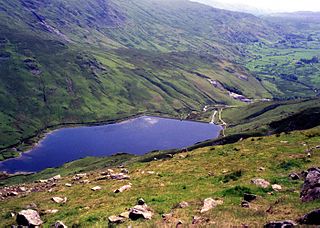
Kentmere Reservoir is a water storage facility situated in the Kentmere valley in the county of Cumbria, England. It is located 10.5 kilometres (6.5 mi) north-northeast of the town of Windermere. The reservoir is fed by the streams which form the headwaters of the River Kent which rise 1.5 kilometres (0.93 mi) to the north in Hall Cove on the southern slopes of a mountainous ridge called High Street, which is named after the nearby Roman road. It is also fed by Lingmell Gill, which drains the large corrie on the western side of Harter Fell beneath the Nan Bield Pass.

Cromford Mill is the world's first water-powered cotton spinning mill, developed by Richard Arkwright in 1771 in Cromford, Derbyshire, England. The mill structure is classified as a Grade I listed building. It is now the centrepiece of the Derwent Valley Mills UNESCO World Heritage Site, and is a multi-use visitor centre with shops, galleries, restaurants and cafes.

The remains of Letheringsett Brewery Watermill are located in the centre of the village of Letheringsett in the county of Norfolk. The watermill of 1784 was housed within the maltings and brewery complex founded and run by John Brereton of Letheringsett Hall from before 1721. Much of this complex still stands on the south side of the A148 Cromer to King’s Lynn road, which bisects the village on an east–west axis, and on the west bank of the River Glaven, which bisects the village south–north.
Textile manufacturing is one of the oldest human activities. The oldest known textiles date back to about 5000 B.C. In order to make textiles, the first requirement is a source of fibre from which a yarn can be made, primarily by spinning. The yarn is processed by knitting or weaving to create cloth. The machine used for weaving is the loom. Cloth is finished by what are described as wet process to become fabric. The fabric may be dyed, printed or decorated by embroidering with coloured yarns.

Ring spinning is a spindle-based method of spinning fibres, such as cotton, flax or wool, to make a yarn. The ring frame developed from the throstle frame, which in its turn was a descendant of Arkwright's water frame. Ring spinning is a continuous process, unlike mule spinning which uses an intermittent action. In ring spinning, the roving is first attenuated by using drawing rollers, then spun and wound around a rotating spindle which in its turn is contained within an independently rotating ring flyer. Traditionally ring frames could only be used for the coarser counts, but they could be attended by semi-skilled labour.

The Cathedral Green Footbridge is a pedestrian and cycle swing bridge in the centre of Derby, spanning the River Derwent. It forms a third side to a triangle between The Cathedral and the Silk Mill Museum.

Silk throwing is the industrial process wherein silk that has been reeled into skeins, is cleaned, receives a twist and is wound onto bobbins. The yarn is now twisted together with threads, in a process known as doubling. Colloquially silk throwing can be used to refer to the whole process: reeling, throwing and doubling. Silk had to be thrown to make it strong enough to be used as organzine for the warp in a loom, or tram for weft.

Congleton, Macclesfield, Bollington and Stockport, England, were traditionally silk-weaving towns. Silk was woven in Cheshire from the late 1600s. The handloom weavers worked in the attic workshops in their own homes. Macclesfield was famous for silk buttons manufacture. The supply of silk from Italy was precarious and some hand throwing was done, giving way after 1732 to water-driven mills, which were established in Stockport and Macclesfield.
Hawkshead is a civil parish in the South Lakeland District of Cumbria, England. It contains 68 listed buildings that are recorded in the National Heritage List for England. Of these, one is listed at Grade I, the highest of the three grades, four are at Grade II*, the middle grade, and the others are at Grade II, the lowest grade. The parish is in the Lake District National Park. It contains the village of Hawkshead, and the smaller settlements of Hawkshead Hill and Outgate, and the surrounding countryside. Most of the listed buildings are in Hawkshead village, and include houses, shops, public houses, churches and associated structures, a former grammar school, a town hall, and a telephone kiosk. Outside the village are more houses, farmhouses, farm buildings, a former mill, bridges, a chapel, an animal pound, a water pump in a shelter, and another telephone kiosk.
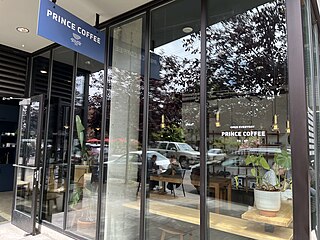
Prince Coffee is a coffee shop in Portland, Oregon, United States.
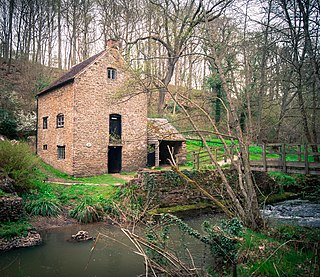
Knowles Mill is the remains of an eighteenth-century water-powered grain mill, located in the Wyre Forest in Worcestershire, England. The mill has been owned by the National Trust since 1938. The mill and its surroundings feature extant machinery, as well as notable populations of adders and wood cranesbill.